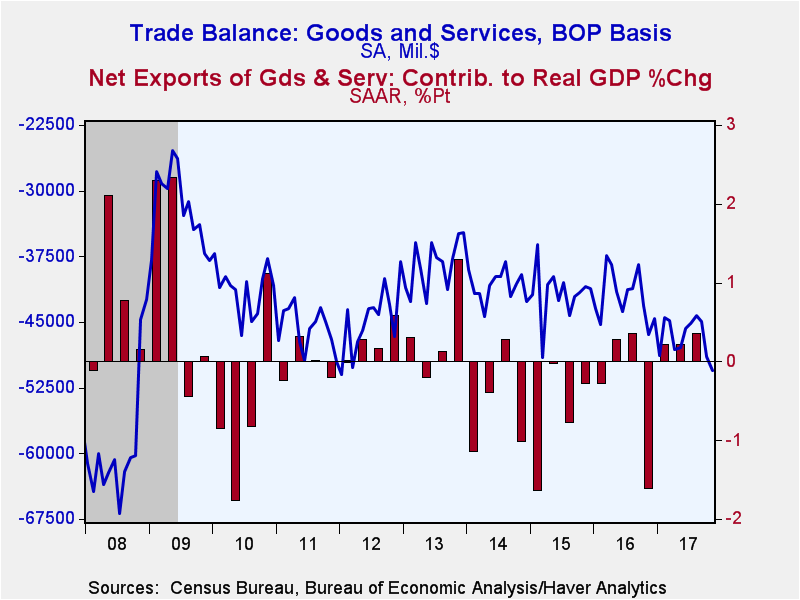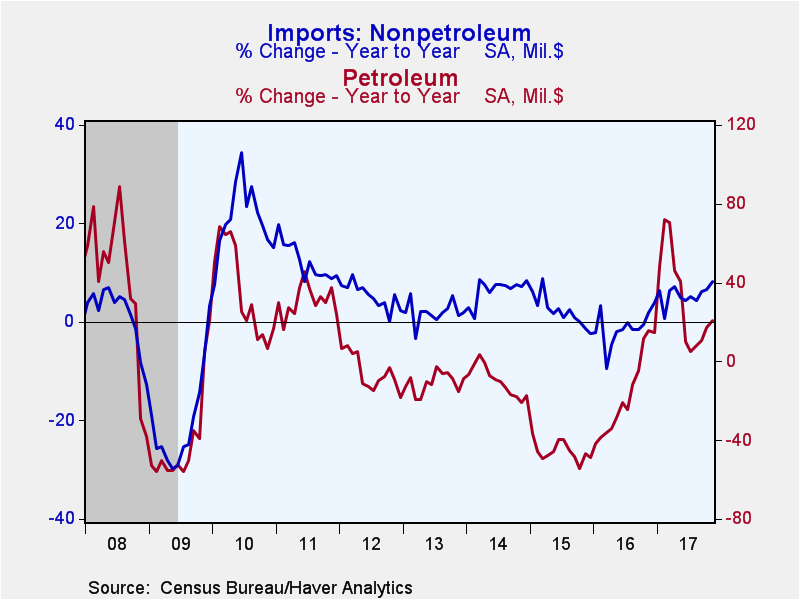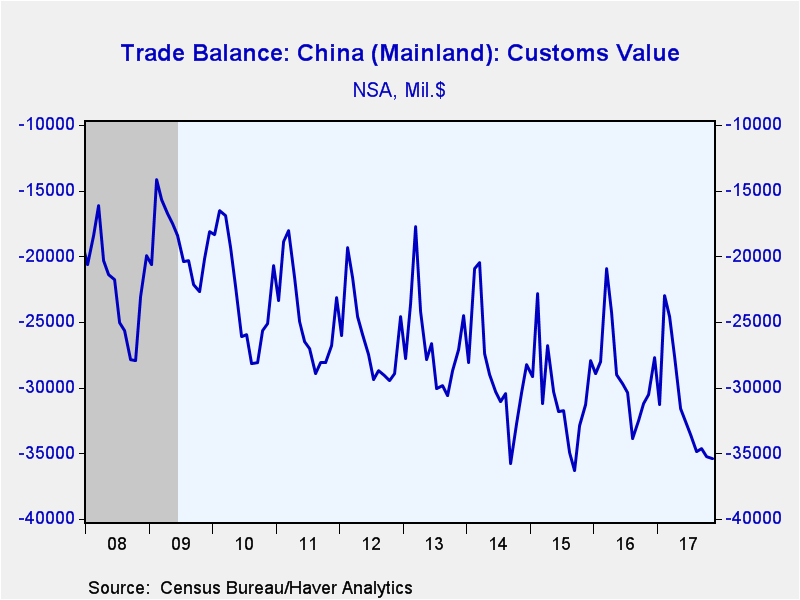 Global| Jan 05 2018
Global| Jan 05 2018U.S. November Trade Deficit Widens Even Though Exports Rebound
by:Sandy Batten
|in:Economy in Brief
Summary
The U.S. trade deficit in goods and services widened to $50.5 billion in November from a slightly upwardly revised $48.9 billion in October. The November deficit was meaningfully larger than the consensus expectation of $49.1 billion [...]
The U.S. trade deficit in goods and services widened to $50.5 billion in November from a slightly upwardly revised $48.9 billion in October. The November deficit was meaningfully larger than the consensus expectation of $49.1 billion from the Action Economics Forecast Survey. Both exports and imports exhibited sharp monthly increases in November. Exports rose 2.3% m/m (8.3% y/y) after having fallen 0.1% m/m in October. Imports increased 2.5% m/m (8.4% y/y) on top of a 1.6% m/m rise in October. In the first two months of the fourth quarter of 2017, the trade balance has widened markedly from its Q3 level, indicating that the external sector will exert a meaningful drag on overall GDP in Q4.
The November increase in the goods and services deficit reflected an increase in the goods deficit of $1.7 billion to $70.9 billion and a slight increase in the services surplus of $0.1 billion to $20.4 billion. Year-to-date, the goods and services deficit increased $53.4 billion to $513.6 billion from the same period in 2016. Exports increased $112.7 billion or 5.6 percent. Imports increased $166.1 billion or 6.7 percent over the first 11 months.
Despite the widening of the goods deficit, goods exports rose 3.4% m/m (10.6% y/y). This was the largest monthly increase since December 2016. The increase was widespread across end-use categories. Auto exports led the November increase--they were up 7.7% m/m (11.3% y/y). Apart from their January 2017 surge, this was the strongest monthly gain for auto exports since March 2011. Exports of capital goods jumped 5.6% m/m (9.9% y/y), and exports of nonauto consumer goods rose 4.0% m/m (3.8% y/y). This was the second largest monthly jump in capital goods exports since September 2009. Goods imports increased 3.1% m/m (9.2% y/y) in November. Again, the increase was relatively widespread. Rising petroleum prices pushed up imports of industrial supplies and materials 5.1% m/m (13.2% y/y). Imports of nonauto consumer goods jumped up 4.8% m/m (6.4% y/y), and capital goods imports increased 2.9% m/m (13.7% y/y).
The value of petroleum imports surged 10.1% m/m (20.9% y/y) in November on top of an 8.5% monthly rise in October. As in October, the November increase was due mostly to a higher price for petroleum. Removing the impact of price changes, the real value of petroleum imports edged up 0.8% m/m (-3.0% y/y) in November. The per barrel cost of crude petroleum jumped up again in November, rising to $50.10 from $47.26 (6.0% m/m). That was the highest price since July 2015 and up from a February 2016 low of $27.49. The value of nonpetroleum imports increased 2.5% m/m (8.2% y/y) in November.
The trade surplus in services was little changed for the second consecutive month at $20.4 billion. Services exports edged up 0.1% m/m (3.9% y/y) while services imports were unchanged in November (+5.9% y/y). By end-use categories, rises and falls in services exports were relatively evenly distributed. Maintenance and repair exports slumped 3.2% m/m while exports of financial services rose 0.6% m/m. End-use services imports generally rose with a 2.5% m/m drop in transport services offsetting increases in all other categories.
By country, the goods trade deficit with China widened slightly to $35.4 billion (NSA) from $35.2 billion in October from $30.5 billion a year ago. The trade deficit with the European Union widened m/m to $14.7 billion (NSA) in November from $13.7 billion in October, but was little changed from a year ago.
The international trade data can be found in Haver's USECON database. Detailed figures are available in the USINT database. The expectations figures are from the Action Economics Forecast Survey, which is carried in AS1REPNA.
| Foreign Trade in Goods & Services (Current Dollars) | Nov | Oct | Sep | Y/Y | 2016 | 2015 | 2014 |
|---|---|---|---|---|---|---|---|
| U.S. Trade Deficit | $50.5 bil. | $48.9 bil. | $44.9 bil. | $46.4 bil. (11/16) |
$504.8 bil. | $500.4 bil. | $490.3 bil. |
| Exports of Goods & Services (% Chg) | 2.3 | -0.1 | 1.1 | 8.3 | -2.5 | -4.7 | 3.6 |
| Imports of Goods & Services (% Chg) | 2.5 | 1.6 | 1.2 | 8.4 | -1.9 | -3.6 | 4.0 |
| Petroleum (% Chg) | 10.1 | 8.5 | 2.2 | 20.9 | -19.4 | -45.5 | -9.7 |
| Nonpetroleum Goods (% Chg) | 2.5 | 1.3 | 1.2 | 8.2 | -1.2 | 2.2 | 6.5 |
Sandy Batten
AuthorMore in Author Profile »Sandy Batten has more than 30 years of experience analyzing industrial economies and financial markets and a wide range of experience across the financial services sector, government, and academia. Before joining Haver Analytics, Sandy was a Vice President and Senior Economist at Citibank; Senior Credit Market Analyst at CDC Investment Management, Managing Director at Bear Stearns, and Executive Director at JPMorgan. In 2008, Sandy was named the most accurate US forecaster by the National Association for Business Economics. He is a member of the New York Forecasters Club, NABE, and the American Economic Association. Prior to his time in the financial services sector, Sandy was a Research Officer at the Federal Reserve Bank of St. Louis, Senior Staff Economist on the President’s Council of Economic Advisors, Deputy Assistant Secretary for Economic Policy at the US Treasury, and Economist at the International Monetary Fund. Sandy has taught economics at St. Louis University, Denison University, and Muskingun College. He has published numerous peer-reviewed articles in a wide range of academic publications. He has a B.A. in economics from the University of Richmond and a M.A. and Ph.D. in economics from The Ohio State University.










